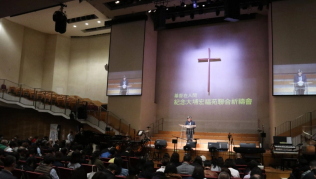Ancient frescoes depicting the early Christians and some scenes from the Bible were uncovered in Rome's oldest catacomb located near the Appian Way.
The frescoes, estimated to be 1,600 years old, revealed a "fusion" of pagan symbols and images related to the Christian faith, indicating recent conversion from paganism to Christianity, project head Barbara Mazzei said, according to The Telegraph.
"It's a fusion of older pagan symbols with new Christian images. The family had only recently converted to Christianity," project head Barbara Mazzei said.
Painted from the catacombs' ceiling are colorful artworks showing famous biblical scenes, such as Jesus feeding the five thousand, Daniel and the lions and Noah's Ark.
An image of Jesus Christ, seated on a throne with a man on his right and another on his left, could be seen at the center. The men were believed to be either the apostles Peter and Paul or St. Nerius and St. Achilleus.



These images were not always visible, as the catacombs' ceilings used to be completely black.
"When we started work, you couldn't see anything - it was totally black. Different wavelengths and chromatic selection enabled us to burn away the black disfiguration without touching the colours beneath," Mazzei said.
"Until recently, we weren't able to carry out this sort of restoration - if we had done it manually we would have risked destroying the frescoes," she added.
The frescoes had been covered with algae, smoke stains from oil lamps and calcium deposits for centuries. They were restored through the use of laser technology that effectively peeled off the grime, revealing the fascinating artwork beneath.
The Domitilla catacombs are among the most extensive catacombs in Rome, stretching more than 17 kilometers in four levels of underground caves that go down to 100 feet. They are also among the best preserved, although some parts of the cave are no longer accessible.
They belonged to noblewoman Flavia Domitilla, granddaughter of the Emperor Vespasian and niece of Domitian. Domitilla and her husband were accused of being atheists, which at the time probably meant they were both Christians. Her husband was condemned to death in 95 A.D., and she was exiled to the island of Ventotene.
The catacombs were abandoned after the fall of the Roman Empire and were only rediscovered in the 16th century by archaeologist Antonio Bosio, whose name could be seen written on the frescoes.
Aside from showing the family's conversion from paganism to Christianity, the frescoes also gave details about the grain trade. A series of frescoes showed that grain, carried by ship from the Mediterranean to the port of Ostia, was loaded on smaller boats that traversed the Tiber River going to warehouses located at the city center.
At the time, Roman citizens were given a daily ration of bread, and the grain trade was monopolized by state officials, who became rich because of it.
The crypts in the Domitilla catacombs were created for the wealthy merchants who were part of the grain trade. According to Fabrizio Bisconti, superintendent of the Pontifical Commission for Sacred Archaeology, rich Romans were among the last to convert to Christianity.
"They were all pagan until the middle of the fourth century AD," he said. This would explain the mixture of pagan and Christian symbols in the frescoes.
Cardinal Gianfranco Ravasi, head of the pontifical commission, spoke at a news conference this week about the catacombs' importance to the Christian faith.
"These tombs represent the roots of our deepest identity, the roots of Rome and of Christianity," he said.
More tombs scattered in the catacombs are still waiting to be restored.







